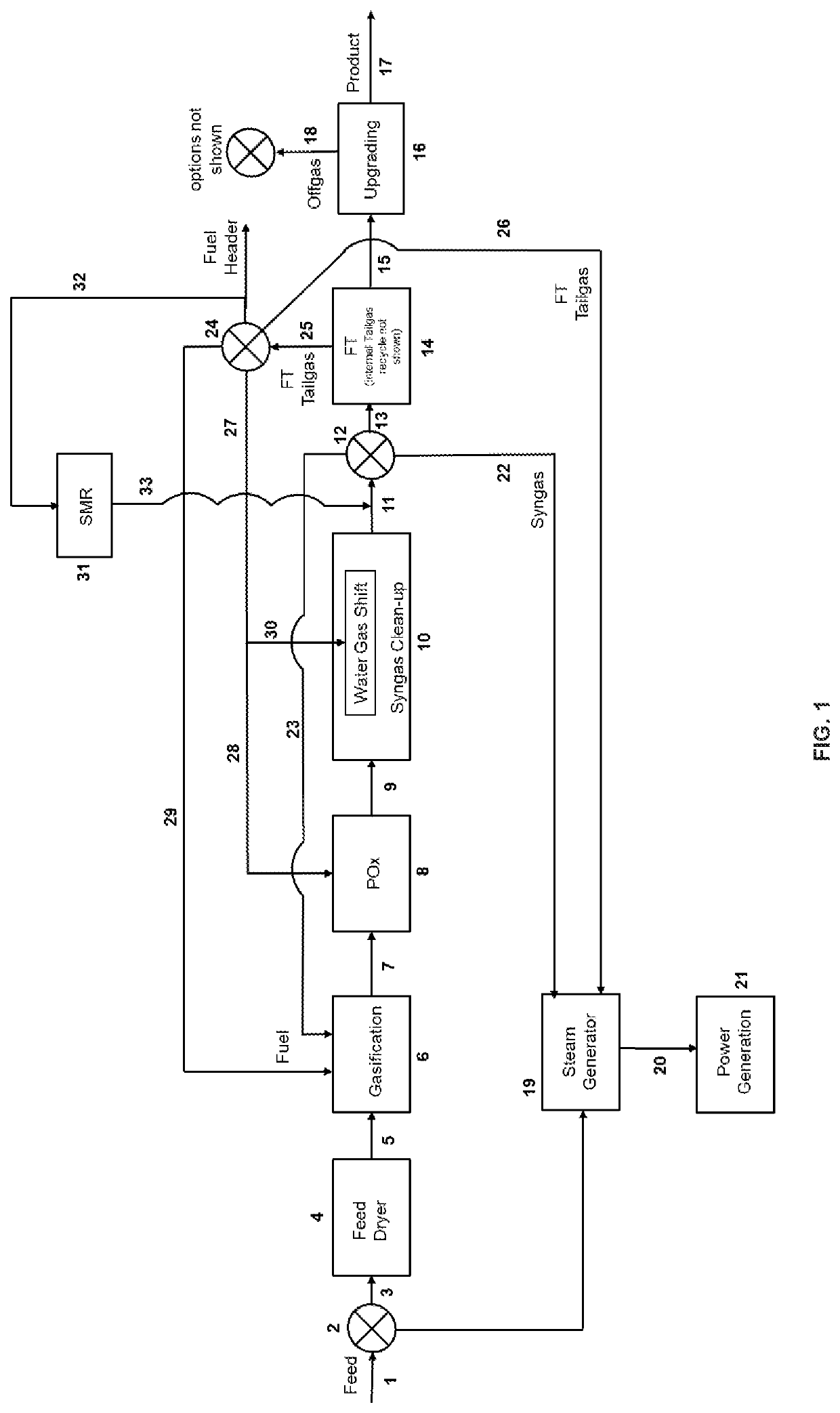Process
a technology of chemical engineering and process, applied in the direction of combustible gas production, combustible gas purification/modification, sustainable manufacturing/processing, etc., can solve the problem that none of these documents provides a satisfactory means for controlling carbon intensity in an otherwise functional wtl or btl process, and achieves significant greenhouse gas reduction, fewer greenhouse gas emissions, and improved overall carbon recovery
- Summary
- Abstract
- Description
- Claims
- Application Information
AI Technical Summary
Benefits of technology
Problems solved by technology
Method used
Image
Examples
example 1
[0245]Table 1 illustrates a comparison of the facility performance for 2 scenarios (using municipal solid waste as feedstock). Case A illustrates the situation corresponding to a minimization of the natural gas import (in order to reduce the carbon intensity score and also to reduce operating cost). To achieve this, a part of the syngas generated from gasification of the feedstock is used as fuel in the combustion heaters for the gasification unit. In comparison, Case B illustrates a situation where natural gas is imported and all generated syngas is used for fuel production. It is clear from table below, that ˜14% production can be gained by importing natural gas instead of the syngas being used as fuel. However, the carbon intensity score is negatively affected.
TABLE 1Case BCase AMaximizeMinimizefuelNG importproductionMSW dry to gasifier, t / d~1000 1XSyngas from gasification, (lbmol / h / stpd)~7 1XO2 usage from gasification + POx~50 1X(lb / h / stpd)Syngas used as fuel, (lbmol / h / ...
example 2
[0246]Table 2 compares the impact of FT tailgas recycle to the POx unit in order to reduce the natural gas import to improve the carbon intensity score of the facility (using municipal solid waste as feedstock). A small reduction in production of the order 1% is observed while NG import is reduced by approximately 30%.
TABLE 2Case BCase C NoFT TailgasFT Tailgasrecycle torecycle toPOxPOxMSW dry to gasifier, t / d~1000 1XSyngas from gasification, (lbmol / h / stpd)~7 1XO2 usage from gasification + POx~50 1X(lb / h / stpd)Syngas used as fuel, (lbmol / h / stpd)00Syngas to FT, (lbmol / h / stpd)~5 1XFT C5+ product, bpsd~1,440~1.02XPower import, MW~25 ~1XNatural gas import, lb / h / stpd3.224.49% Natural gas imported as fuel for96.2%39.6%gasification% Natural gas imported POx 0%48.5%% FT Tailgas recycle as fuel51.3% 100%% FT Tailgas recycle to POx48.7% 0%Relative CI score, g(CO2-eq) / MJ(low)(high)
example 3
[0247]Table 3 below compares the impact of FT tailgas recycle to the WGS unit in order to reduce the natural gas and power import to improve the carbon intensity score of the facility (using biomass as feedstock). For the case of no FT tailgas recycle, all tailgas is assumed to be used for production of additional SH / HP steam and superheated MPS in the flue gas boiler. All superheated steam is used for power generation. The absence of tailgas recycle reduces the syngas to FT and therefore the FT C5+ product production, but it also reduces both the power and natural gas import which has the effect of reducing the carbon intensity score of the facility. The facility design will be based on a trade-off between the carbon intensity score and revenue generation from the sale of transportation fuel products.
TABLE 3No FTFTBaseTailgasTailgascaserecycleto WGSBiomass dry, stpd~1,000 1X 1XSyngas from gasification,~8 1X 1Xlbmol / h / stpdO2 usage from gasification + POx~50 ~0.9X ~0.9X(l...
PUM
| Property | Measurement | Unit |
|---|---|---|
| pressure | aaaaa | aaaaa |
| pressure | aaaaa | aaaaa |
| operating temperature | aaaaa | aaaaa |
Abstract
Description
Claims
Application Information
 Login to View More
Login to View More - R&D
- Intellectual Property
- Life Sciences
- Materials
- Tech Scout
- Unparalleled Data Quality
- Higher Quality Content
- 60% Fewer Hallucinations
Browse by: Latest US Patents, China's latest patents, Technical Efficacy Thesaurus, Application Domain, Technology Topic, Popular Technical Reports.
© 2025 PatSnap. All rights reserved.Legal|Privacy policy|Modern Slavery Act Transparency Statement|Sitemap|About US| Contact US: help@patsnap.com


